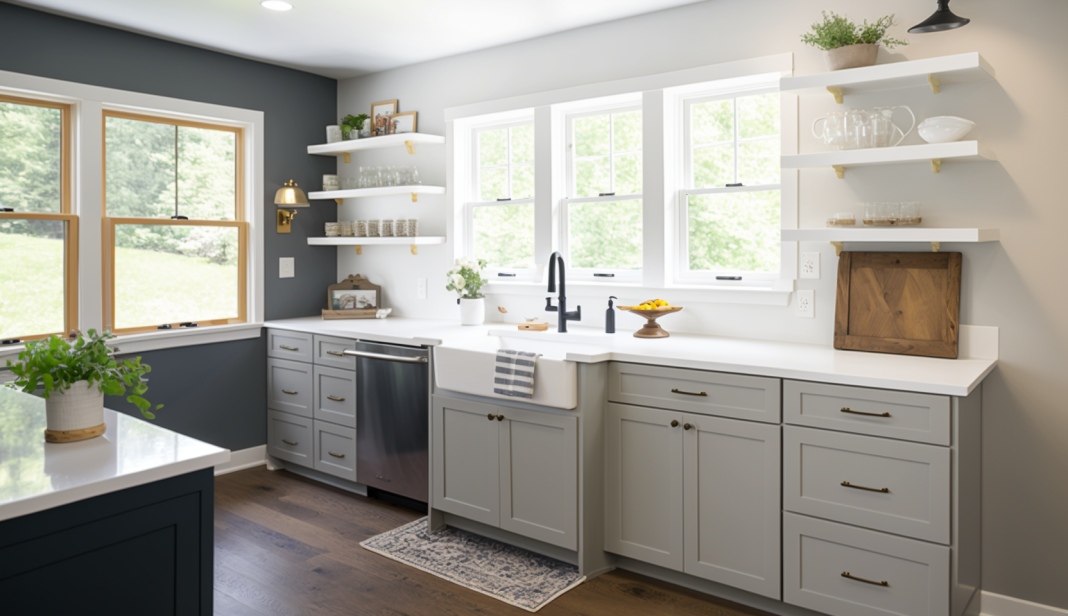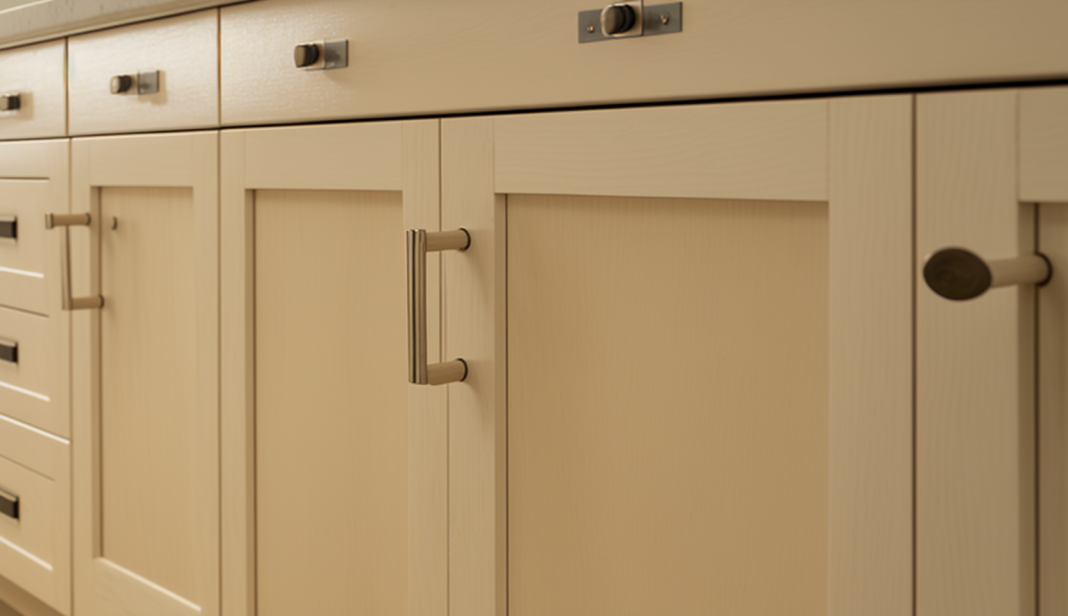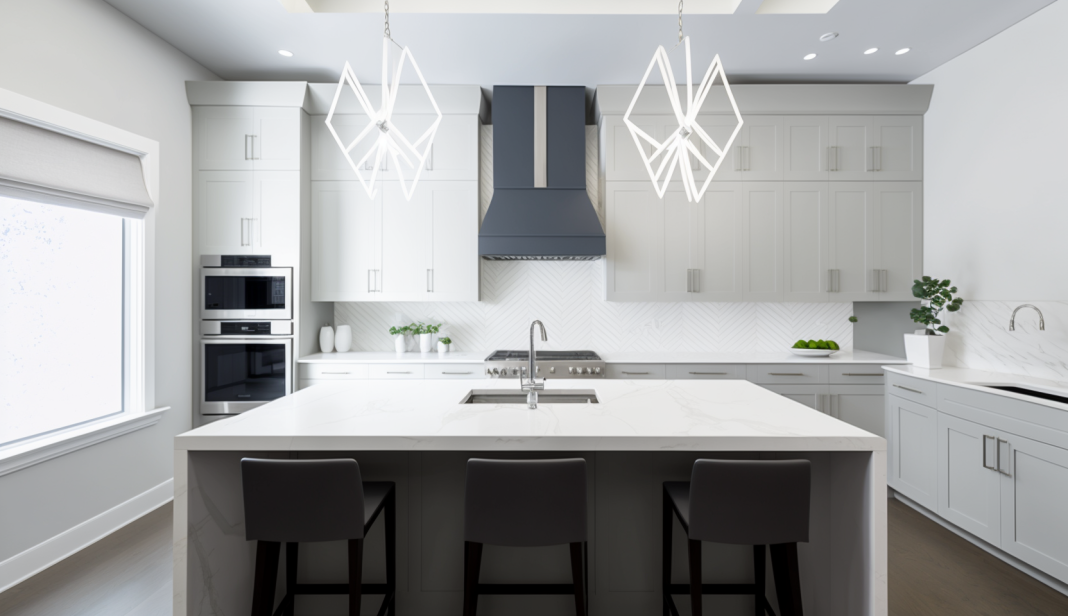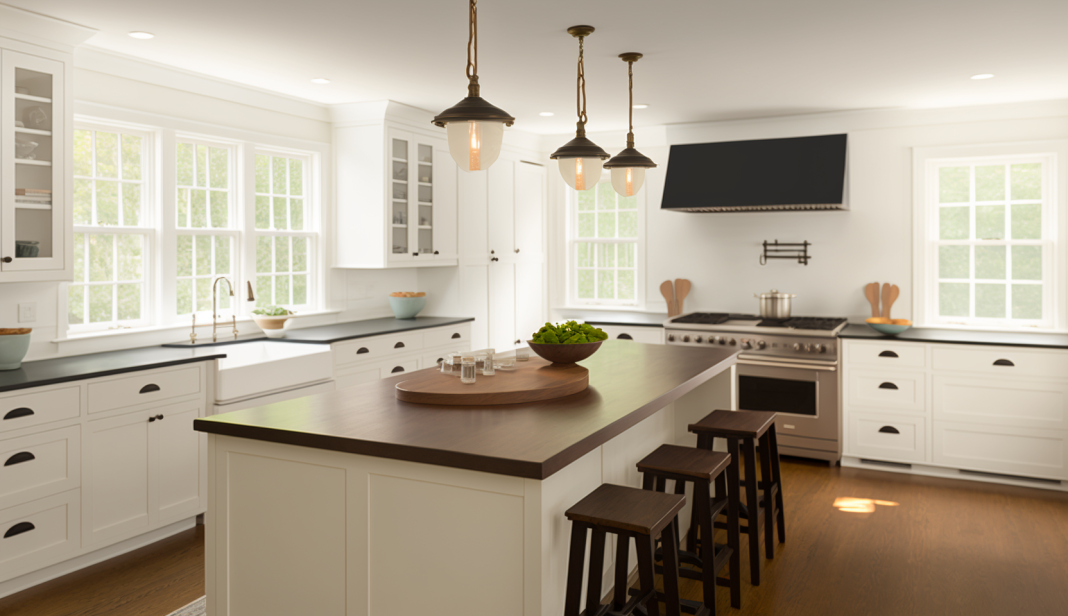Shaker-style kitchens have captivated homeowners and interior designers alike for their simplicity, functionality, and timeless elegance. This design philosophy is rooted in the Shaker religious movement of the late 18th century in the United States and emphasizes high-quality craftsmanship, durability, and practicality. This article delves into Shaker-style kitchens, exploring design ideas, materials, essential elements, and how to incorporate Shaker aesthetics into contemporary kitchen spaces seamlessly.
History and Popularity of Shaker-Style Kitchens
The Shaker Religious Sect
The roots of Shaker-style kitchens can be traced back to the Shaker religious sect, also known as the United Society of Believers in Christ’s Second Appearing. Founded in the 18th century, the Shakers were known for their commitment to living simple, honest, and communal lives. They believed in hard work, humility, and a harmonious relationship with nature and fellow human beings.
Reflecting Values in Design
The Shakers’ core values of simplicity, honesty, and quality were evident in their way of life and manifested in their design approach. When creating furniture and cabinetry, the Shakers embraced a minimalist aesthetic with a strong focus on functionality. They believed that beauty lies in utility and sought to eliminate unnecessary embellishments, resulting in a clean, unadorned, yet timeless design language.
Popularity of Shaker-Style Kitchens
Clean Lines and Uncluttered Appearance
One of the key reasons for the enduring popularity of Shaker-style kitchens is their clean and uncluttered appearance. The simplicity of the design lends a sense of calm and serenity to the space, making it an inviting and relaxing environment. In a world often filled with visual noise, Shaker-style kitchens offer fresh air and a retreat from the chaos of everyday life.
Timeless Appeal
The Shaker style’s timeless appeal also contributes to its popularity. Unlike fleeting design trends that come and go, Shaker-style kitchens have stood the test of time. Their classic, understated elegance continues to captivate homeowners and interior designers alike, making them versatile for various home styles and personal preferences.
Focus on Functionality
Functionality is at the heart of Shaker-style kitchens. The emphasis on practicality and usability make them a practical choice for modern living. Shaker cabinets often feature well-organized storage solutions, such as pull-out drawers and adjustable shelving, maximizing every inch of space and keeping kitchen essentials within easy reach.
Adaptability to Personalization
Despite their minimalist nature, Shaker-style kitchens are highly adaptable to personalization. Homeowners can infuse their unique touch by choosing various finishes, hardware, and color schemes. Shaker-style kitchens can be customized to match your taste and lifestyle, whether you prefer a traditional or contemporary look.
Perfect Blend of Tradition and Modernity
Shaker-style kitchens strike a perfect balance between tradition and modernity. While they pay homage to historical design principles, their clean lines and versatile features make them compatible with modern appliances and technology. This seamless blend of the old and new appeals to those seeking a classic and up-to-date kitchen.
Shaker Kitchen Design Ideas
Shaker-style kitchens exude timeless elegance and functionality, making them popular for homeowners seeking a harmonious blend of simplicity and quality in their living spaces. If you’re looking to create a Shaker-inspired kitchen, consider these design ideas to curate a space embodying this classic style’s essence.
Color Schemes
- Embrace Neutrals: Neutral colors form the foundation of a Shaker-style kitchen. Opt for soft shades like white, gray, beige, or gentle pastels to create a serene and calming environment. These hues allow the natural light to bounce off the surfaces, enhancing the bright and airy feel of the space.
- Celebrate Natural Wood Tones: Incorporate natural wood tones into your kitchen design to further connect with nature. Woods like maple, cherry, or oak add warmth and authenticity to the space, highlighting the craftsmanship of the cabinetry and furniture. Consider using wooden elements for cabinet doors, flooring, or a wooden kitchen island for a touch of rustic charm.
Layout and Functionality
- Prioritize Practicality: A hallmark of Shaker-style kitchens is their focus on functionality. When designing your kitchen layout, emphasize practicality and ease of use. Arrange the key components, such as the stove, sink, and refrigerator, in a convenient triangle to facilitate smooth movement during cooking.
- Maximize Storage: Efficient storage solutions are vital for keeping a Shaker kitchen clutter-free. Incorporate open shelving to display your best-looking kitchenware and keep frequently used items within easy reach. Large drawers offer excellent organization for pots, pans, and utensils, while deep cabinets can house larger appliances and pantry items.
- Abundant Counter Space: A Shaker-style kitchen must have Ample counter space. This allows you to prepare meals comfortably and offers room for food plating or casual dining. Consider extending the counters to create an inviting breakfast bar or a cozy spot for coffee.
- Seamlessly Connected Spaces: The Shaker design philosophy promotes a seamless connection between the kitchen and other living areas. Consider an open floor plan that merges the kitchen with a family room or dining area, promoting a sense of togetherness and effortless flow between spaces.

Lighting and Accessories
- Subtle Lighting: Illuminate your Shaker kitchen with understated lighting fixtures that complement the overall design. Pendant lights hanging above islands or countertops can add a warm glow, enhancing the inviting atmosphere of the kitchen. Soft, diffused lighting also helps to create a cozy ambiance during evening gatherings.
- Minimalist Accessories: When accessorizing a Shaker-style kitchen, less is more. Opt for carefully selected decorative items, such as woven baskets or artisan pottery, to add a touch of personality without overwhelming the design’s clean lines. Keep clutter to a minimum, allowing the beauty of the kitchen’s craftsmanship to take center stage.
Shaker Kitchen Cabinets Materials
Regarding Shaker-style kitchen cabinets, the choice of materials plays a crucial role in bringing out the essence of this timeless design. Here are some popular materials that capture the heart of the Shaker aesthetic.
Solid Wood: A Timeless Favorite
Solid wood is the hallmark of Shaker-style cabinets, and for a good reason. The most popular wood types for Shaker cabinets include:
- Maple: Maple wood boasts a smooth and consistent grain pattern, lending a sense of elegance to the cabinets. Its light color allows for versatility in staining or finishing, making it an excellent choice for various kitchen styles.
- Cherry: Cherry wood exudes warmth and richness, developing a deep, reddish-brown patina. The natural aging process adds character to the cabinets, making them even more charming as the years go by.
- Oak: Oak is renowned for its durability and distinctive grain pattern. Shaker-style cabinets crafted from oak exude a sense of strength and stability, making them a reliable choice for long-lasting kitchen furniture.

Durability and Masterful Craftsmanship
Shaker-style kitchens are known for their commitment to durability and quality craftsmanship. Each cabinet is carefully constructed to withstand the test of time, reflecting the Shakers’ value of simplicity and longevity. From the meticulous joinery to the choice of hardware, every detail is thoughtfully considered to ensure the cabinets look great and function flawlessly, even with daily use.
Environmentally-Friendly Options
For those seeking eco-friendly options, there are sustainable choices available for Shaker-style cabinets:
- Sustainable Wood Sources: Opting for sustainably sourced wood demonstrates a commitment to environmental preservation. Look for certifications like the Forest Stewardship Council (FSC), which ensures responsible forest management and sustainable harvesting practices.
- Low VOC Finishes: Volatile Organic Compounds (VOCs) are traditional paint and finish chemicals that can release harmful gases into the air. Low VOC finishes are a healthier and eco-conscious alternative, contributing to better indoor air quality.
- Reclaimed or Salvaged Wood: Choosing reclaimed or salvaged wood for your Shaker cabinets adds a unique and rustic charm and reduces the demand for new timber. This environmentally-conscious choice breathes new life into old materials, reducing waste and creating a one-of-a-kind kitchen design.
Essential Elements of Shaker Kitchens
Shaker kitchens are renowned for their timeless simplicity, practicality, and focus on quality craftsmanship. Consider incorporating these essential elements into your design to create an authentic and functional Shaker-style kitchen.
Cabinet Design: Classic Elegance
The hallmark of Shaker-style kitchens lies in their cabinet design. Shaker cabinets feature a five-piece door design with a recessed center panel. The frame comprises four pieces, while the center panel is flat or slightly raised. This classic and versatile design transcends time, making it a perfect fit for traditional and modern kitchen aesthetics. Shaker cabinets effortlessly adapt to your style, whether you prefer a cozy farmhouse kitchen or a sleek contemporary space.
Hardware: Understated and Functional
When it comes to hardware, Shaker-style kitchens embrace simplicity and functionality. Handles and knobs are often unadorned, allowing the wood’s and cabinetry’s beauty to take center stage. Common materials for Shaker hardware include brushed or polished nickel, stainless steel, or black iron. These understated choices maintain the focus on functionality while seamlessly complementing the overall design aesthetic.
Countertops and Flooring: Natural Beauty
Natural materials are significant in Shaker kitchens, particularly for countertops and flooring. When choosing countertops, choose stone or quartz surfaces that balance visual appeal and durability. Granite, marble, and quartz countertops are popular choices, exuding elegance and practicality in equal measure. For the flooring, hardwood or tile options work best. Traditional hardwood floors add warmth and character, while ceramic or porcelain tiles provide a practical, easy-to-clean solution.
Storage and Organization: Efficient and Uncluttered
Efficiency and organization are at the core of Shaker-style kitchens. The design prioritizes maximizing storage space while maintaining an uncluttered appearance. Incorporate open shelving to display your favorite kitchenware, creating an inviting and personalized touch. Ample drawers are essential for storing pots, pans, and cutlery, ensuring easy access to your cooking essentials. Consider pull-out storage solutions for spices, oils, or utensils, keeping your workspace tidy and functional.
Incorporating Shaker Style in Contemporary Kitchens
Shaker style, with its timeless charm and functional elegance, can be seamlessly incorporated into contemporary kitchens for a unique and inviting space. Here are some tips on blending traditional Shaker elements with modern design to create a kitchen that perfectly balances the old and the new.
Mixing Modern and Traditional Elements
- Embrace Modern Materials: Incorporate modern materials, such as stainless steel appliances or glass backsplashes, into your Shaker-style kitchen. These contemporary touches add a sleek and sophisticated edge while complementing the classic Shaker cabinets and wood accents.
- Harmonize Colors and Finishes: Opt for a harmonious color scheme bridging the traditional and contemporary gap. Neutral hues work well as a backdrop, allowing the natural beauty of the wood and modern elements to stand out. Consider using a light color palette with pops of bold hues for a fresh and vibrant ambiance.

Budget-Friendly Tips and DIY Projects
- Repurpose and Revamp: If you’re on a budget, consider repainting your existing cabinets to achieve the desired Shaker color scheme. A fresh coat of paint can work wonders in transforming the look of your kitchen. Additionally, replacing old hardware with simple, Shaker-inspired handles or knobs can create an instant update without a hefty price tag.
- DIY Shaker Elements: Get creative with DIY projects to infuse authentic Shaker style into your kitchen. Building your Shaker-style cabinet doors or crafting a custom kitchen island can be rewarding and cost-effective. Not only will it save you money, but it will also add a personal touch to your kitchen design.
Adapting the Style for Different Home Types
- Versatility in Design: Shaker-style kitchens are incredibly versatile and can be adapted to suit various home types. Whether you live in a traditional country cottage or a sleek urban apartment, the Shaker aesthetic can be customized to harmonize with the surrounding space.
- Customized to Your Needs: The beauty of the Shaker style lies in its ability to cater to individual preferences. Tailor the design to fit your needs, such as integrating additional storage solutions, customizing the layout for optimal functionality, or adding a cozy breakfast nook for family gatherings.
Conclusion
The enduring appeal of Shaker-style kitchens lies in their simplicity, functionality, and timeless elegance. The design’s focus on high-quality craftsmanship and materials ensures that a Shaker kitchen will look beautiful and stand the test of time. With a wealth of design ideas, materials, and essential elements, it’s easy to see why Shaker-style kitchens continue to captivate homeowners and designers alike. By embracing the Shaker style for your kitchen renovation, you can create a space that is not only visually stunning but also incredibly functional and inviting.
Testimonial:
“When we decided to renovate our kitchen, we knew we wanted a design that was both timeless and functional. After exploring various styles, we were drawn to the simplicity and elegance of Shaker style kitchens. Working with our interior designer, we were able to incorporate Shaker cabinets, natural wood accents, and minimalist hardware to create a beautiful and efficient space that truly feels like the heart of our home. Our Shaker style kitchen has not only transformed our daily lives with its practicality and organization, but it has also become a stunning focal point in our home that we know will stand the test of time.”
Emily and John S., satisfied homeowners
FAQ
Q: What is a Shaker-style kitchen?
A: A Shaker-style kitchen is a design inspired by the Shaker religious movement that values simplicity, functionality, and timeless elegance. It features clean lines, an uncluttered appearance, high-quality craftsmanship, and durable materials.
Q: What colors are typically used in a Shaker-style kitchen?
A: Neutral colors such as white, gray, beige, or soft pastels are commonly used in Shaker-style kitchens. Natural wood tones, like maple, cherry, or oak, are also popular choices.
Q: What types of materials are commonly used in Shaker-style kitchens?
A: Solid wood is the most common material used for Shaker-style cabinets, with maple, cherry, and oak being top choices. Natural materials like stone or quartz are often used for countertops, hardwood, or tile flooring.
Q: What type of hardware is suitable for a Shaker-style kitchen?
A: Simple and functional hardware made from brushed or polished nickel, stainless steel, or black iron suits a Shaker-style kitchen.
Q: How can I create a functional Shaker-style kitchen layout?
A: A functional Shaker-style kitchen layout prioritizes practicality and ease of use, with efficient storage solutions, ample counter space, and seamless connections between the kitchen and other living areas.
Q: Can a Shaker-style kitchen be adapted to fit modern design trends?
A: A Shaker-style kitchen can be adapted to fit modern design trends by blending traditional Shaker elements with contemporary touches, such as stainless steel appliances, glass backsplashes, or minimalist lighting.
Q: How can I achieve a Shaker-style kitchen on a budget?
A: Budget-friendly options include repainting existing cabinets, replacing old hardware with simple, Shaker-inspired handles or knobs, adding open shelving, or undertaking DIY projects like building your own Shaker-style cabinet doors or creating a custom kitchen island.

